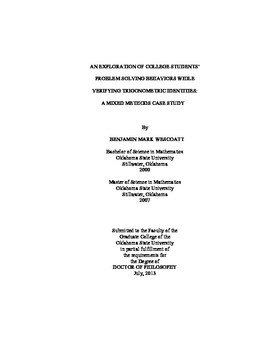| dc.contributor.advisor | Aichele, Douglas B. | |
| dc.contributor.author | Wescoatt, Benjamin | |
| dc.date.accessioned | 2014-09-24T14:17:11Z | |
| dc.date.available | 2014-09-24T14:17:11Z | |
| dc.date.issued | 2013-07 | |
| dc.identifier.uri | https://hdl.handle.net/11244/11054 | |
| dc.description.abstract | Topics in trigonometry have not been well-studied, especially with college-level students. Thus, despite providing a venue for important concepts such as notions of proof and algebraic skill, the process of verifying trigonometric identities, or VTI, has not been thoroughly explored. This study attempts to remedy this gap in the literature by exploring college students' concept images of VTI, providing a description of certain aspects of students' VTI concept images while focusing on students' problem solving and proof making behaviors during VTI. | |
| dc.description.abstract | Students viewed VTI in terms of proof construction and problem solving actions. Overall, students perceived the flow of VTI as a process of simplification involving simplifying acts. Viewing the flow in this way helped students monitor their actions; they tended to choose the complicated expression in order to simplify it or choose manipulative actions that would result in a perceived simpler expression. As for simplifying actions, students used a particular technique, dodging, to marginalize complicated function arguments, allowing them to choose appropriate actions once the cognitive complexity was removed. | |
| dc.description.abstract | As proof constructions, students generally believed VTI provided a verification of the truth or an explanation for the truth of the identity. The role VTI served depended on how students approached the identity prior to VTI, believing the identity to already be true or believing it could potentially be false. In turn, the knowledge students built as a result of the VTI process varied. Many students signaled the conclusion of VTI with a particular construction, the reflexive step. This construction acted as a sign, conveying information about the identity to the prover and readers of the VTI construction. | |
| dc.description.abstract | Students also indicated a preference for the visual nature of the VTI construction; they preferred formats that highlighted the manipulative steps of the construction. Overall, students believed a format that arranged the manipulated expressions in a vertical manner, forming columns, to clearly display the steps. When given the choice, students rated constructions of this format higher than constructions in which the steps were arranged in a horizontal format. Additionally, most students wrote their constructions in the columned format. | |
| dc.format | application/pdf | |
| dc.language | en_US | |
| dc.rights | Copyright is held by the author who has granted the Oklahoma State University Library the non-exclusive right to share this material in its institutional repository. Contact Digital Library Services at lib-dls@okstate.edu or 405-744-9161 for the permission policy on the use, reproduction or distribution of this material. | |
| dc.title | Exploration of college students' problem solving behaviors while verifying trigonometric identities : A mixed method case study | |
| dc.contributor.committeeMember | Francisco, Christopher | |
| dc.contributor.committeeMember | Choike, James R. | |
| dc.contributor.committeeMember | McCann, Melinda H. | |
| osu.filename | Wescoatt_okstate_0664D_12923.pdf | |
| osu.accesstype | Open Access | |
| dc.type.genre | Dissertation | |
| dc.type.material | Text | |
| thesis.degree.discipline | Mathematics | |
| thesis.degree.grantor | Oklahoma State University | |
